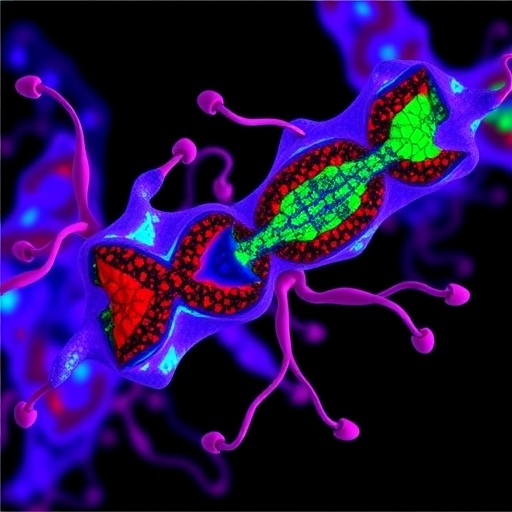In the evolving landscape of cancer treatment, researchers are consistently on the hunt for innovative strategies to enhance therapeutic efficacy, especially in aggressive malignancies like triple-negative breast cancer (TNBC). The dichotomy of immune tolerance and immune activation represents a significant challenge in the modulation of tumor environments. Recently, a research group led by Song et al. introduced a revolutionary bispecific antibody known as BP2402. This novel construct targets both PD-L1 and IL-8, a dual approach that promises exciting implications for enhancing antitumor immunity and altering inflammatory signaling pathways in preclinical models.
PD-L1, an immune checkpoint protein, is known for its role in cancer cells to evade the immune response. By binding to PD-1 on T cells, it effectively inhibits T cell proliferation and cytokine production, creating a dampened immune response. On the other hand, IL-8 is a chemokine associated with tumor progression, which attracts immune cells to the tumor site but paradoxically contributes to an immune suppressive microenvironment. The ability of BP2402 to simultaneously engage both pathways signifies a paradigm shift in therapeutic strategies for TNBC, where conventional monotherapies have often fallen short.
The preclinical studies conducted by the team demonstrated that BP2402 could markedly enhance the infiltration of cytotoxic T cells into the tumor microenvironment. This infiltration is crucial, as on-site T cells can mount a more potent and localized attack against tumor cells. The enhanced antitumor immune response observed results from the bispecific antibody’s ability to block the PD-1/PD-L1 interactions while simultaneously modulating IL-8 signaling, which orchestrates the tumor’s immune infiltrate. These results present an empowering narrative that bi-specific antibodies like BP2402 could galvanize a more robust immune response, steering the body’s defenses toward a more aggressive stance against cancer.
Additionally, researchers noted that the dual inhibition not only improved T cell activity but also reduced the overall levels of IL-8 in the tumor microenvironment. By lowering the levels of this chemokine, BP2402 holds the potential to eliminate the detrimental effects associated with IL-8’s immunosuppressive role. This could lead to an environment where T cells can function more effectively, unencumbered by the cellular signals that typically lead to their exhaustion. The balance between promoting T cell activities and mitigating immunosuppressive signals is critical in cancer therapy, and BP2402 appears to perform this delicate dance with exceptional finesse.
The encouraging findings from the TNBC mouse model indicate that BP2402 not only induces a noteworthy tumor regression but also significantly alters the inflammatory signaling pathways at play. In tumors treated with BP2402, a marked shift towards a pro-inflammatory environment was observed. This change was evidenced by increased production of various cytokines that foster robust immune responses. Such alterations in the inflammatory landscape could indicate a reprogramming of the tumor’s signaling networks, redirecting them towards an anti-tumorigenic profile.
The implications of these findings are vast. Given that TNBC is particularly known for its aggressiveness and lack of targeted therapy options, the advent of a bispecific antibody like BP2402 could herald a new chapter in the treatment of this subtype. It not only provides a dual mechanism of action against tumor escape strategies but also opens up avenues for potential combination therapies with existing standard-of-care agents, ultimately leading to improved outcomes for patients grappling with this disease.
Expanding the breadth of this research, the authors also highlighted that the safety profile of BP2402 was favorable, with no significant adverse effects reported in the treated mice. This data is vital when considering the translation of these findings into clinical settings. A novel therapy’s launch into human clinical trials hinges not just on its efficacy but also on its tolerability. The favorable safety profile of BP2402 sets the stage for future human studies, indicating that it could be a viable addition to the therapeutic arsenal in the fight against TNBC.
As ongoing research continues to validate these preclinical results, scientists are urged to explore the mechanistic pathways further. Understanding how BP2402 modifies the tumor microenvironment at a molecular level could provide crucial insights into further enhancing its efficacy. Potential resistance mechanisms to bispecific antibodies deserve particular attention, ensuring that the therapeutic potency of BP2402 can be maximized in patient populations that may exhibit resistance to monotherapies.
Moreover, the advent of this research aligns with the broader trend of personalized medicine in oncology, whereby treatment is increasingly tailored to the specific characteristics of both the tumor and the patient. The integration of biomarkers that can predict responses to BP2402 could enhance treatment precision, ensuring that patients most likely to benefit from such bispecific therapies are identified beforehand, ultimately optimizing therapeutic choices.
In conclusion, the study conducted by Song et al. surrounding the innovative bispecific antibody BP2402 illustrates a promising frontier in the fight against triple-negative breast cancer. By targeting both PD-L1 and IL-8, the research team is unveiling a potential that fundamentally alters therapeutic interventions and immune engagement strategies. The implications of this breakthrough are vast, offering hope to patients and paving the way for more effective treatment measures that could transform outcomes in the realm of oncology. As the medical community eagerly anticipates the transition of BP2402 from the laboratory bench to the clinical setting, the future may indeed be brighter for those affected by TNBC, as this novel therapeutic option emerges with the potential to shift the current paradigm in cancer treatment.
Subject of Research: Bispecific antibody targeting PD-L1 and IL-8 in triple-negative breast cancer.
Article Title: A novel anti-PD-L1/IL-8 bispecific antibody BP2402 enhances antitumor immunity and modulates inflammatory signaling in triple-negative breast cancer mice model.
Article References:
Song, L., Tang, S., Pi, X. et al. A novel anti-PD-L1/IL-8 bispecific antibody BP2402 enhances antitumor immunity and modulates inflammatory signaling in triple-negative breast cancer mice model.
J Transl Med 23, 1056 (2025). https://doi.org/10.1186/s12967-025-07105-x
Image Credits: AI Generated
DOI:
Keywords: Bispecific antibody, PD-L1, IL-8, triple-negative breast cancer, immunotherapy, tumor microenvironment, T cells, cytokines, safety profile, personalized medicine.




